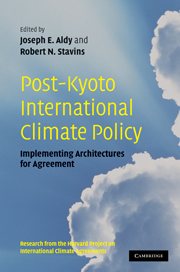Book contents
- Frontmatter
- Contents
- Harvard Environmental Economics Program, International Advisory Board
- Harvard Project on International Climate Agreements, Faculty Steering Committee
- Harvard Project on International Climate Agreements, Project Management
- List of figures
- List of tables
- List of contributors
- Foreword
- 1 Introduction
- Part I Alternative international policy architectures
- Part II Negotiation, assessment, and compliance
- Part III The role and means of technology transfer
- Part IV Global climate policy and international trade
- 16 Global environment and trade policy
- 17 A proposal for the design of the successor to the Kyoto Protocol
- Part V Economic development, adaptation, and deforestation
- Part VI Modeling impacts of alternative allocations of responsibility
- Part VII Synthesis and conclusion
- Appendix A Selected List of Individuals Consulted, Harvard Project on International Climate Agreements
- Appendix B Workshops and Conferences, Harvard Project on International Climate Agreements
- Glossary and Abbreviations
- Index
16 - Global environment and trade policy
Published online by Cambridge University Press: 05 June 2012
- Frontmatter
- Contents
- Harvard Environmental Economics Program, International Advisory Board
- Harvard Project on International Climate Agreements, Faculty Steering Committee
- Harvard Project on International Climate Agreements, Project Management
- List of figures
- List of tables
- List of contributors
- Foreword
- 1 Introduction
- Part I Alternative international policy architectures
- Part II Negotiation, assessment, and compliance
- Part III The role and means of technology transfer
- Part IV Global climate policy and international trade
- 16 Global environment and trade policy
- 17 A proposal for the design of the successor to the Kyoto Protocol
- Part V Economic development, adaptation, and deforestation
- Part VI Modeling impacts of alternative allocations of responsibility
- Part VII Synthesis and conclusion
- Appendix A Selected List of Individuals Consulted, Harvard Project on International Climate Agreements
- Appendix B Workshops and Conferences, Harvard Project on International Climate Agreements
- Glossary and Abbreviations
- Index
Summary
The global climate regime, as represented by the Kyoto Protocol, may be on a collision course with the global trade policy regime, as represented by the WTO (World Trade Organization). Environmentalists fear that international trade will undercut efforts to reduce greenhouse gas (GHG) emissions as carbon-intensive production migrates to non-participating countries—a phenomenon known as leakage. Meanwhile business people fear the adverse effects of disparate climate policies on their own competitiveness. These fears have now become prominent in the policy-making process. In early 2008, legislation to enact long-term targets for reduced GHG emissions included provisions for possible barriers against imports from countries perceived as non-participating—both in Washington, DC (where climate legislation has not yet passed) and in Brussels (where the EU Commission Directive has gone into effect). Such provisions could be interpreted as violating the rules of the WTO, which poses the nightmare scenario of a WTO panel rejecting a major country's climate change legislation. In light of the hostile feelings that such a collision would unleash, it would be a disaster for supporters of the WTO and free trade as much as for supporters of the Kyoto Protocol and environmental protection.
The clash of trade and climate policy is just the latest and largest instance of fears among many environmentalists that the WTO is an obstacle to their goals in general. The issue transcends institutions. For its critics, the WTO is a symbol of globalization, and their concerns attach also to that larger phenomenon.
- Type
- Chapter
- Information
- Post-Kyoto International Climate PolicyImplementing Architectures for Agreement, pp. 493 - 529Publisher: Cambridge University PressPrint publication year: 2009
- 6
- Cited by



